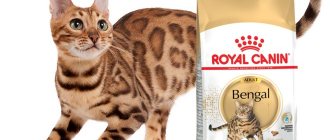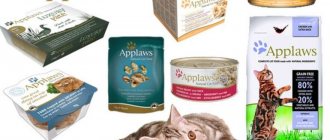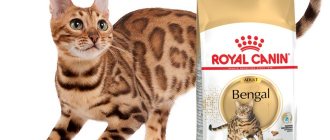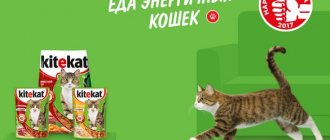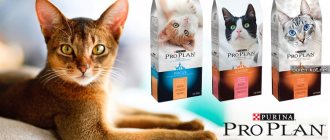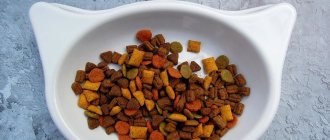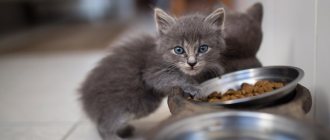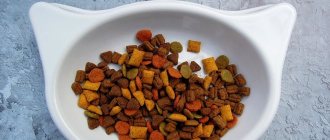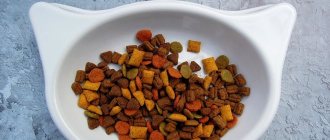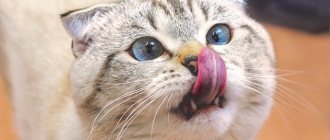What will you learn from the article?
- How to store wet food for cats Rules for storing wet food in bags (pouches)
- Rules for storing wet food in other types of packaging
- Shelf life of wet cat food
- How long can opened canned food be stored in the refrigerator?
- Can wet food be frozen?
- How to keep dry food fresh
Storing cat food correctly means taking care of the health, well-being and longevity of your pet. Only in feeds that are stored correctly, the taste, aroma and all useful microelements and vitamins are preserved for a long time.
In our article we will tell you how to store cat food correctly, for how long and where. We'll tell you how to keep dry and wet cat food fresh longer.
Features of dry food storage
Let's look at how to properly store food if the package is not opened even after it has been opened.
If the package is not opened
If the food packaging has not been opened, then there is no need to come up with anything special. Place it in a dry, dark and cool place. For example, in a cupboard, and thus the food will remain until the expiration date indicated on the label.
When purchasing food, pay attention to the packaging. It should be slightly swollen, which means that the pack contains nitrogen inside. It is added to prevent oxidation of fats and other substances contained in the product. Nitriding acts as a conservation agent. If the packaging is completely deflated and its bag of food can be rolled up freely, it means that it is not sealed and somewhere there is a small hole through which nitrogen has escaped and air has entered. This means that the food began to oxidize and deteriorate. He won't last a whole year.
It is for this reason that I do not recommend buying food in bulk - it is unknown when they were opened and how long they have been stored in the store.
If the package is opened
After opening the package, the main task is to limit the access of oxygen to the product as much as possible. Therefore, part of the food from a large pack should be poured into a container, and the rest should be left in the original packaging, carefully releasing the air from the bag and rolling it up. I don’t recommend simply closing the food with a zip fastener, as there will be a lot of air left in the empty space of the bag. It is better to twist the bag and secure the food on top with clothespins, plastic food clips or office clips. This way we can slow down the process of product spoilage.
We fold the bag and secure it with a clip, minimizing the entry of air inside.
For better insulation, can be wrapped in a plastic bag
If you buy food in small bags - 250-400 grams, you don’t have to pour it anywhere, as your pet will eat it very quickly. But since it is expensive, and the cat eats much more per month, most cat owners prefer larger packs.
Always store food closed - open food not only deteriorates, fats in it oxidize and it begins to smell unpleasant, and moisture evaporates from it, which is present, although in small quantities. If the food is left open during the day, it will become tough, as the 5-10% moisture it contains will evaporate. Your cat may refuse it altogether. But even if he doesn’t refuse, there will be little benefit from such a product. Some cats may vomit from eating stale food.
Manufacturers' recommendations
Due to the structure and processing features of food in industrial packaging, it can be stored unopened for up to 18 months (these indicators may vary among different manufacturers). But after a package of dry food has been opened, it must be used up within 4-7 weeks, and it is important to follow the correct storage requirements for dry food. It is necessary to avoid moisture, heating by a radiator or direct sunlight, and free access to oxygen. Failure to comply with these rules leads to the fact that the food quickly loses its characteristics, fat oxidation occurs, and in rare cases insects can even appear in the food. Let's look at a few simple storage rules.
Rule No. 1. No free air access
Most manufacturers have thought about the convenience of using food bags from a storage point of view. Most packs of small-volume dry food for cats and dogs are equipped with convenient zip-lock fasteners that can be easily unfastened and fastened, reliably protecting the food inside from external influences.
In the case of more economical large packages, such fasteners are not provided. It is recommended to use special tanks for storing dry food. But there is a secret here: in order to minimize contact of food with air, it is recommended to use a small container along with the tank. For example, once a week, transfer food from a tank to a container in the amount you need for several days. This way you will need to open the sealed tank less often, and it is easier to place a small container closer to the feeding area.
Rule No. 2. No moisture or heat.
A small survey. Where exactly do you think dry food is stored in most apartments? Of course, closer to a bowl of food and a convenient storage cabinet. We bet that most of the answers are “kitchen.” And this is the wrong solution for dry food. High humidity, heat, storage cabinets are often located near heating appliances and water pipes, so this room is not the best choice for dry food storage, even if a sealed plastic container is used. Consider placement options in the hallway, closet, corridor, or even on a warm glazed loggia.
Rule No. 3. No temperature changes.
We've dealt with heat. What about the cold? It would seem that with negative values nothing will happen to the food, but they should also be avoided. Any temperature changes are not desirable for food of this consistency; this will negatively affect the taste characteristics and quality of the product. In addition, you should not feed your dog cold food, either wet or dry.
Where to store - container and place
As I have already described, it is better to pour part of the food, 500-800 grams, into a container and give it to your pet every day. The rest should be sent for storage in original packaging.
You can choose different containers for storage - glass, porcelain, plastic, tin. The main condition is that each container must have a tightly closing ground or screw-on lid.
Do not use containers that are too large - the larger the volume, the more air will enter the feed each time. The smaller the volume, the faster the pet will eat it, the fresher the food will be. It simply won't have time to deteriorate.
Let's look at the pros and cons of different container options.
Plastic container . The main advantages are that it is light, comfortable and cheap. You won’t break it, it’s convenient to take it with you if, for example, you go with your cat to the country for a few days in the summer. For a long time I used plastic containers, but over time I replaced them. The fact is that a plastic jar quickly gets dirty and is also saturated with the smell of food, which is difficult to clean. I also noticed that food is stored worse in plastic than, for example, in glass. This was detected both by the smell of the food and by the cat’s reaction. Yes, yes, my cat categorically refuses to eat rancid, oxidized food. You can easily check the quality of the product on it.
If you do choose plastic, it must be food grade. Do not store food in containers intended for storing household items and other inedible items. To make sure that the plastic in front of you is food grade, look at the bottom of the container - there should be a spoon and fork icon there - either on the plastic itself or on the label. Non-food grade plastic can leach toxic compounds into food.
Glass jar is the most preferred option
Tin container . Tin containers, in particular aluminum, have the following disadvantage - aluminum reacts with food and can change the taste of the product (the same applies to dishes for people). If you choose a tin container with oxidation protection (all modern metal utensils for people have this protective layer and are therefore safe), then this problem will disappear by itself.
Glass or porcelain containers. Both options are considered the most preferable. Now I use glass containers with a plastic lid. Such containers can be bought in any dishware department - these are jars for storing cereals. In glass and porcelain, food is stored longer, it does not lose its smell, the smell does not eat into the walls of the dish, and the animal is full and satisfied.
Store the containerized food in a dark and dry place, away from sunlight, to avoid overdrying and mold formation (in case of high humidity).
How to understand that a product is spoiled
It is difficult to understand by appearance whether dry food has spoiled or not. Things are much simpler with wet products. You can visually see when the food is not suitable for eating:
- Dried on top.
- Covered with film or mold.
Usually, pets themselves determine by the smell that the food is ready for consumption. If the animal refuses to eat the offered treat, there is a high probability that it has spoiled.
How long to store
According to my observations, the maximum adequate storage time for food after opening the package and subject to the above storage recommendations is 2 months. During this time, it does not dry out, does not go rancid, and the cat eats it with pleasure.
Based on this, calculate the size of the pack of food. For example, if you have one pet, then do not buy a package weighing more than 3 kg.
If there are more cats, then you can buy both 5 and 10 kg - options for breeders or for those who have 2,3 or more cats.
Health to your cats.
Variety of preservatives
Preservatives, which include antioxidants and antioxidants, help protect feed from oxidation. When oxidized, the granules acquire a bitter taste, deteriorate and lose their nutritional value.
There are also special preservatives, without which various harmful microorganisms (molds and various pathogenic microflora) can develop in the feed.
Tocopherol (vitamin E), ascorbic acid (vitamin C), citric acid, rosemary, or various combinations thereof are often used as natural preservatives. These substances are more expensive, but much healthier and completely safe. It is important that the manufacturer clearly states the names of the preservatives added so that you can tell whether they are natural or artificial. Based on this, you can make the right choice for the health of your pet.
Problem of choice
At the time of purchase, you should always pay attention to the condition of the packaging. It should be slightly swollen, which indicates its complete tightness. Inside the bag there is nitrogen, which the manufacturer uses as a preservative. When the packaging easily rolls up, this indicates a violation of its seal. There is no longer any nitrogen inside, and the process of oxidation of the product has begun as a result of exposure to oxygen. In such a pack, the storage of food for dogs and cats will be very short, so it is not worth buying it.
Buying loose feed is undesirable for the same reason. Nobody knows the degree of its freshness. This means that the quality of the product will be very questionable.
The manufacturer indicates how long dry food can be stored on the packaging. Usually it is 1 – 2 years in closed form. For a product containing vitamin E – 6 months. Once the package is opened, this time is significantly reduced.
Useful tips
If pellets or uneaten wet meat pieces are transferred to glass containers, the food name portion of the container should always be retained. The date of opening must be indicated on it in order to know exactly the expiration date of the product.
If, as a result of feeding an animal, problems arise, it will always be clear which manufacturer’s food caused this. Then in the future it will be possible to avoid repeating mistakes.
Considering how long open dry food can be stored, it is purchased in packages of the appropriate size so that the animal does not have to eat an expired product. You should not buy loose feed at all: it may be past its expiration date.
Before storing pet food in a container, it is better not to remove it from the manufacturer's package.
